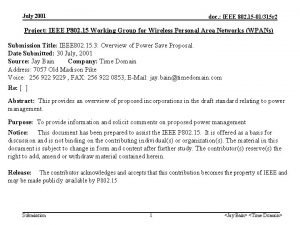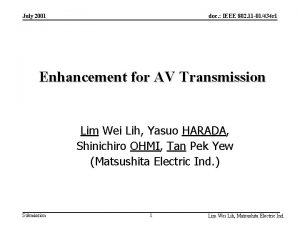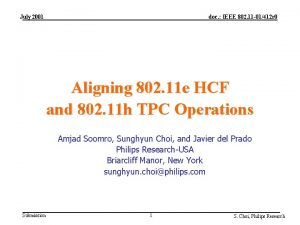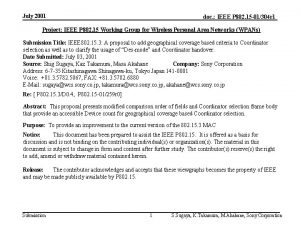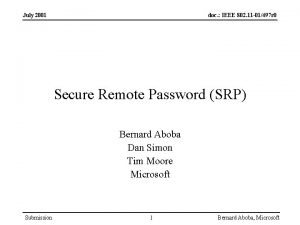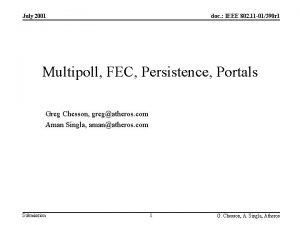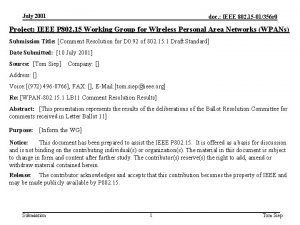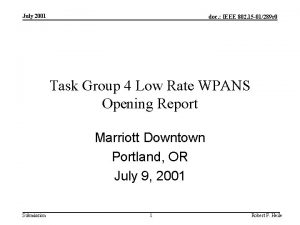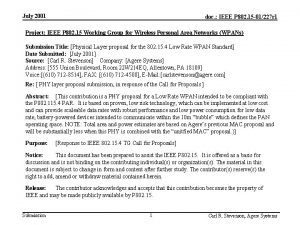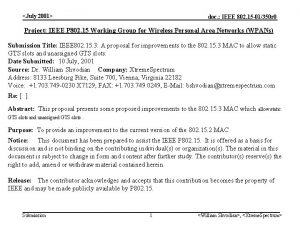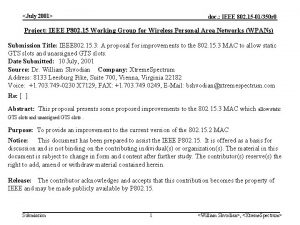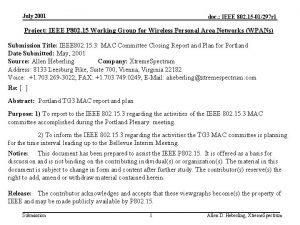July 2001 doc IEEE P 802 15 01359













- Slides: 13

July 2001 doc. : IEEE P 802. 15 -01/359 r 0 TG 4 Project: IEEE P 802. 15 Working Group for Wireless Personal Area Networks (WPANs) Submission Title: [Low-Band Phy Agere / Honeywell] Date Submitted: [July 2001 ] Source: [Carl R. Stevenson / Pat Gonia] Company: [Agere Systems / Honeywell] Address [555 Union Boulevard, Room 22 W 214 EQ, Allentown, PA 18109] Voice: [(610) 712 -8514], FAX: [(610) 712 -4508], E-Mail: [carlstevenson@agere. com, gonia_patrick@htc. honeywell. com] Re: [revision of IEEE P 802. 15 -01/227 TG 4 r 1 after TG 4 decision on baseline phy at 2. 4 GHz DSSS. ] Abstract: [Revision of Agere proposal now focussed on 868 -928 band integrating Zig. Bee’s narrow band draft proposal. ] Purpose: [to be considered as low-band PHY option] Notice: This document has been prepared to assist the IEEE P 802. 15. It is offered as a basis for discussion and is not binding on the contributing individual(s) or organization(s). The material in this document is subject to change in form and content after further study. The contributor(s) reserve(s) the right to add, amend or withdraw material contained herein. Release: The contributor acknowledges and accepts that this contribution becomes the property of IEEE and may be made publicly available by P 802. 15. NOTE: Update all red fields replacing with your information; they are required. This is a manual update in appropriate fields. All Blue fields are informational and are to be deleted. Black stays. After updating delete this box/paragraph.

July 2001 doc. : IEEE P 802. 15 -01/359 r 0 TG 4 Physical Layer Proposal Overview for Narrow Band operation in both 902 -928 MHz and 868 -870 MHz BANDS Agere / Honeywell

July 2001 doc. : IEEE P 802. 15 -01/359 r 0 TG 4 Overview: A low-cost hardware platform to service both 915 and 868 MHz bands • Merger of Agere NB PHY proposal (IEEE P 802. 1501/227 TG 4 r 1) and one of the proposed Zig. Bee PHY options • Compatibility with proposed baseline IEEE 802. 15. 4 MAC • Operating under FCC Part 15. 249 and CEPT/ERC Rec 70 -03 • Proven, high performance all-digital modem possible • conventional mod/demodulators could be used

July 2001 doc. : IEEE P 802. 15 -01/359 r 0 TG 4 Frequency Band: • Adaptive channel selection to avoid interference • Coordinator node “sniffs” band selects channel(s) • Slave nodes find coordinator by scanning for beacons • Network moves to a clear channel in case of interference • Approximately 500 channels proposed for the 902 -928 MHz band. • Channel spacing 50 KHz. • Center frequencies F= (915 + 0. 05 K) MHz with K= +/- 0, 1………. 250

July 2001 doc. : IEEE P 802. 15 -01/359 r 0 TG 4 Frequency Band: • Up to 12 channels can be used in the 868. 0 to 868. 6 band (1% duty cycle. ) • Up to 10 channels can be used in the 868. 7 to 869. 2 band (0. 1% duty cycle. ) • Up to 5 channels can be used in the 869. 4 to 869. 25 band (10% duty cycle) • Up to 6 channels can be used in the 869. 7 to 870 band (100% duty cycle) • Duty cycle requirements must be observed.

July 2001 doc. : IEEE P 802. 15 -01/359 r 0 TG 4 Transmitter Characteristics: Power Output • Power output in the range of 5 -10 d. Bm for 915 MHz. • At 915, power level will be selected to control maximum field strength to 50 mv/m at 3 meters per FCC 15. 249 regulations while using a very low-cost printed antenna. • More Tx power is allowed in 868 band.

July 2001 doc. : IEEE P 802. 15 -01/359 r 0 TG 4 Transmitter Characteristics: Modulation • Frequency shift modulation (FSK) Spurious Emissions • Compliant to FCC 15. 249 and ETSI regulations.

July 2001 doc. : IEEE P 802. 15 -01/359 r 0 TG 4 Transmitter Characteristics: Spectrum Mask • There are no specific rules on spectrum mask in FCC part 15. 249 or ETSI. Out-of-Band Spurious Emissions • Compliant to FCC 15. 249 and ETSI regulations.

July 2001 doc. : IEEE P 802. 15 -01/359 r 0 TG 4 Transmitter Characteristics: Radio Frequency Tolerance • A 35 ppm window is proposed ( 50 or 100 ppm may be possible). – A reasonable compromise to accommodate lowcost and acceptable performance

July 2001 doc. : IEEE P 802. 15 -01/359 r 0 TG 4 Receiver Characteristics: Receiver Reference Sensitivity Level • Better than -100 d. Bm for a BER of 10 Receiver Maximum Input Level • -20 d. Bm for a BER of 10 -4 -4

July 2001 doc. : IEEE P 802. 15 -01/359 r 0 TG 4 Receiver Characteristics: Spurious Emissions • Compliant to FCC 15. 249 and ETSI regulations. Receive/Transmit Turn-Round Time • Receive/transmit and transmit/receive turn-round times should be less than 250μsec

July 2001 doc. : IEEE P 802. 15 -01/359 r 0 TG 4 NB v. s. DSSS at 868 MHz and 915 MHz More NB channels with dynamic channel selection – Gives better interference avoidance – More independent networks supported NB: Can be lower power consumption than DSSS Many NB solutions are currently available – DSSS is not available now in the cost range NB has better sensitivity DSSS cost can approach NB but will not be lower NB can be extremely simple

July 2001 doc. : IEEE P 802. 15 -01/359 r 0 TG 4 Recommendation Given the newly selected PHY at 2. 4 GHz DSSS and the stated need for an alternate at 868 -928: This NB proposal should be more fully developed and optimized for the new (lower band) scoping - To optimally fit both 915 and 868 requirements - To eliminate any (now) unnecessary consideration of 2. 4 GHz - To optimize for a distinguished market space from 2. 4 GHz PHY














